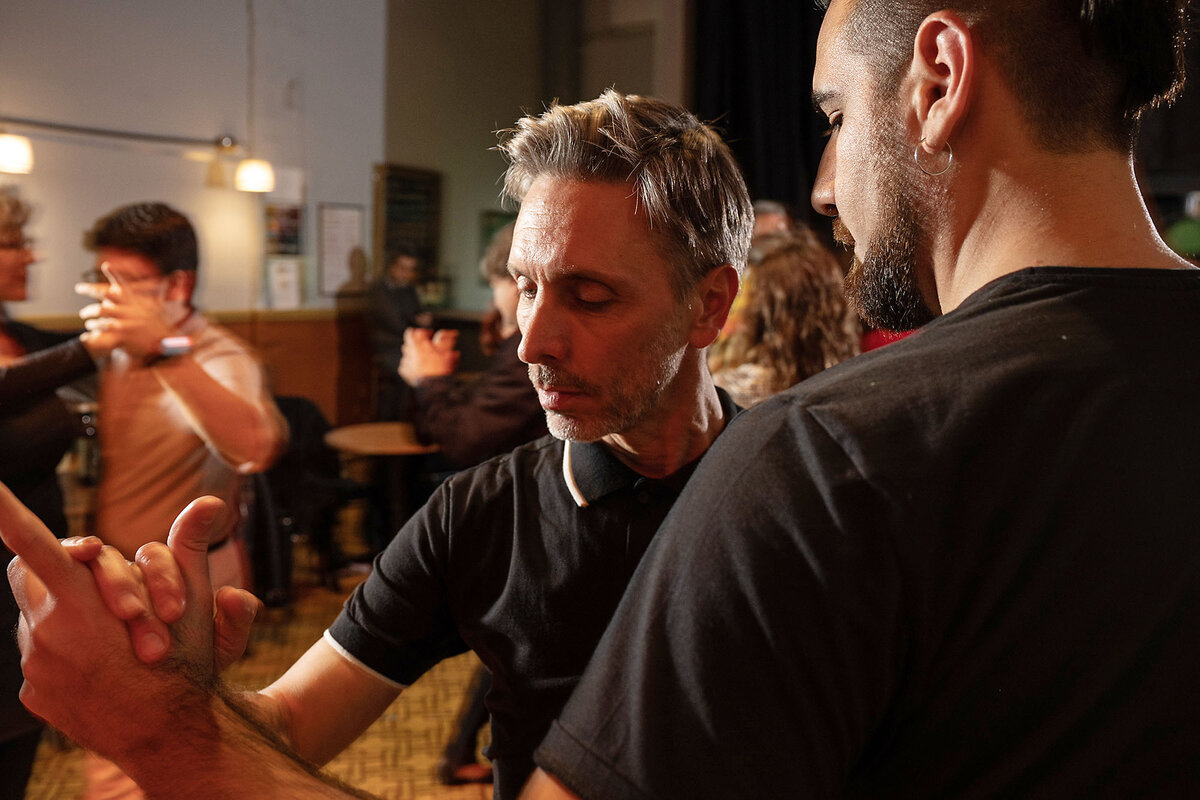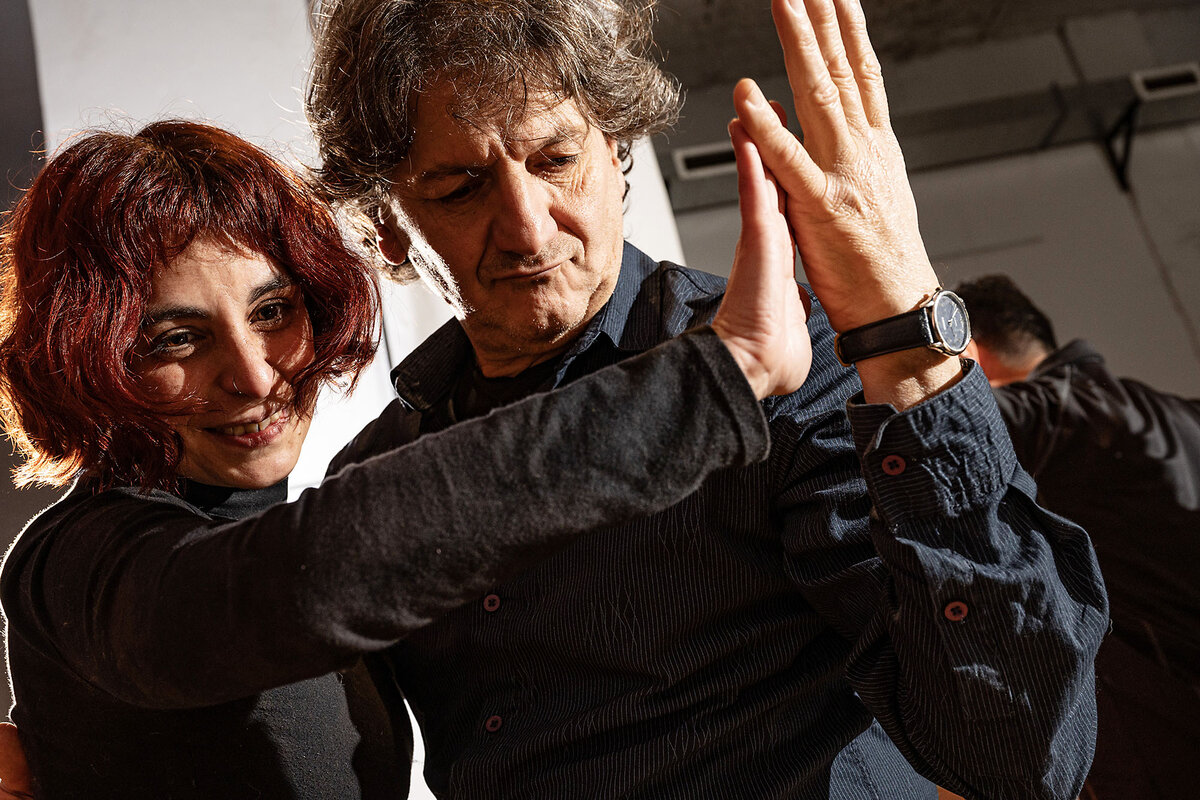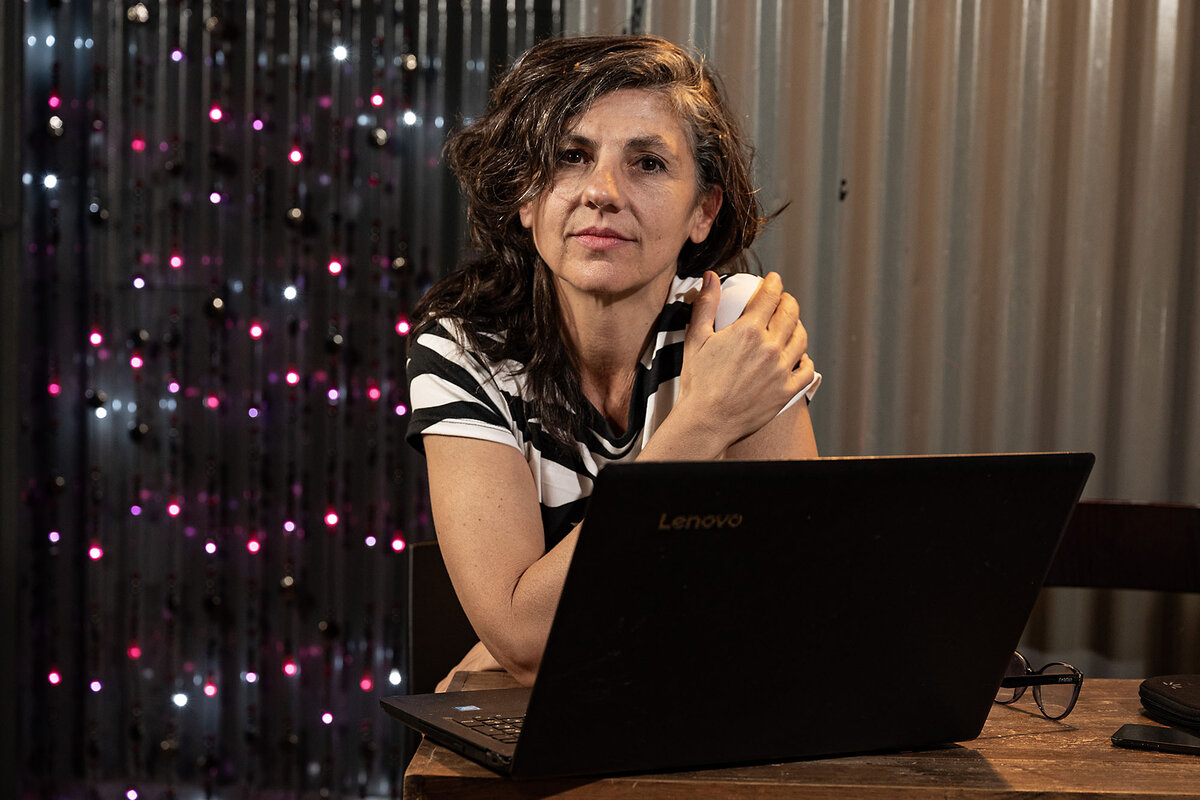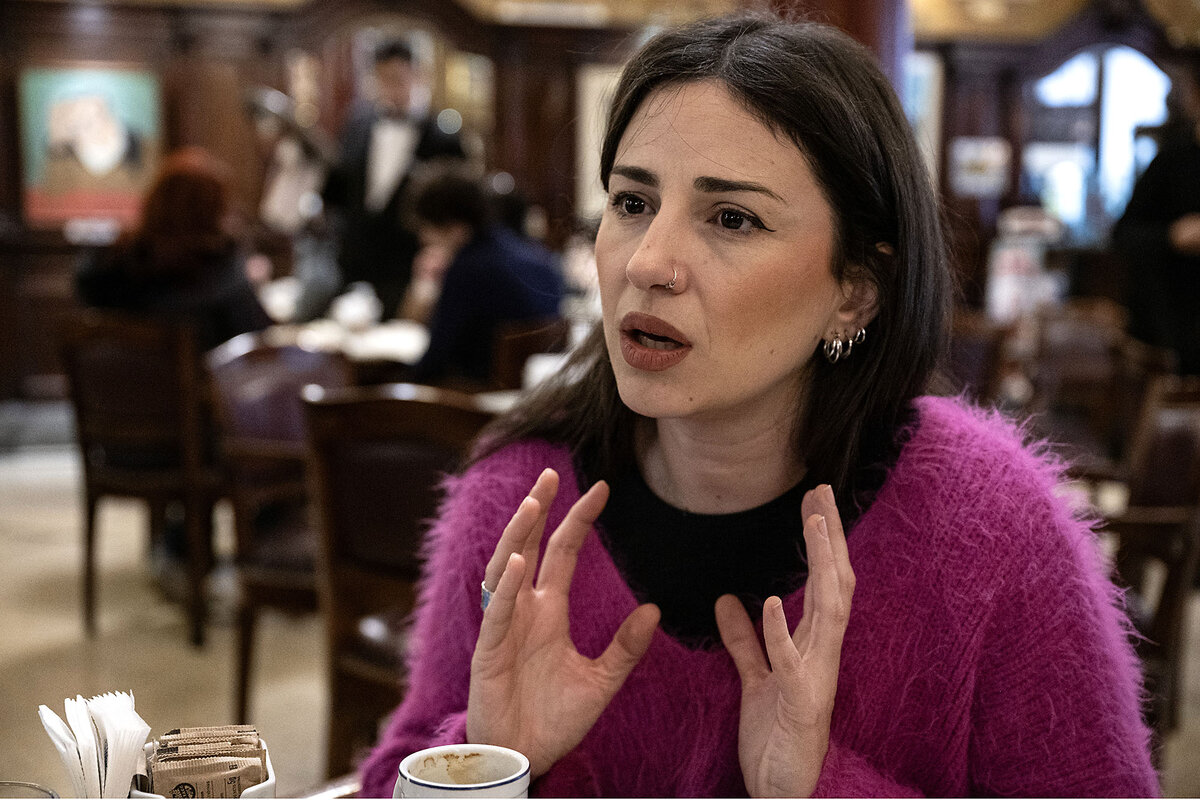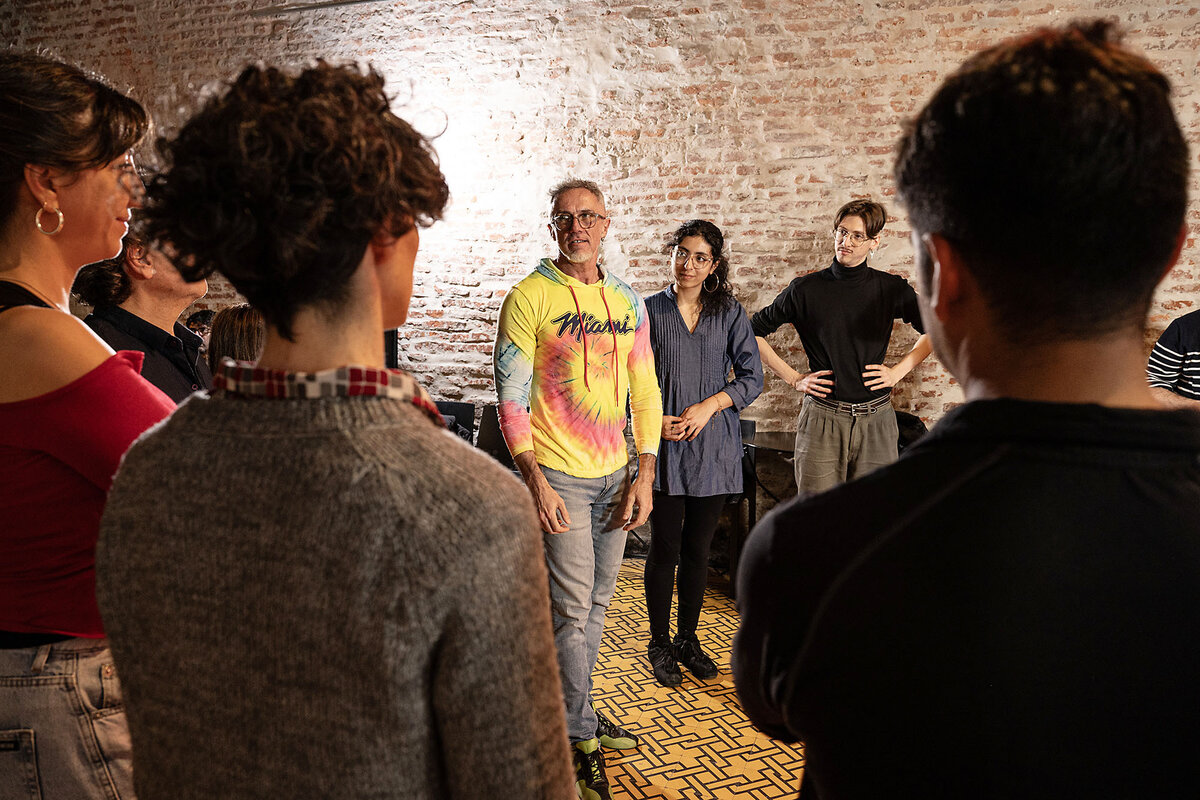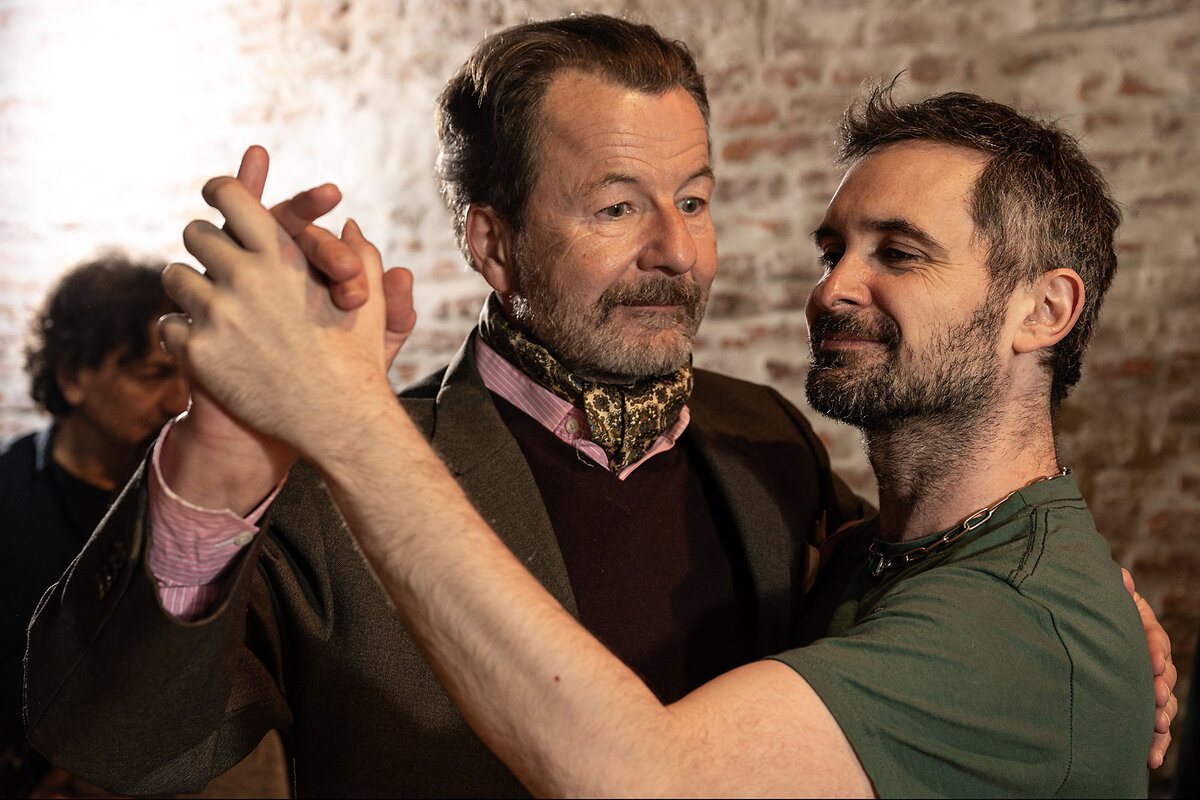Tango for all? How Argentine artists are upending stereotypes.
Loading...
| BUENOS AIRES, Argentina
At the glitzy Buenos Aires tango world championship, couples glide across the stage in the classic moves of Argentina’s national dance. Men with smoldering eyes and tight, dark suits lead their female partners – in their obligatory stiletto heels – turning and grasping them close. A woman’s bare leg occasionally rises provocatively up the man’s thigh, as musicians sing of romance and betrayal.
Elsewhere in Buenos Aires, in working-class-turned-hipster neighborhoods of the capital, local cultural centers host tango evenings and master classes called milongas with a strikingly different vibe.
The recorded music and the dance steps are recognizably tango, but the couples, some in jeans and sneakers, hint that this is something distinct. In some, women dance with women, or men dance with men, and in the mixed-sex couples, the women often lead the men.
Why We Wrote This
Tango may conjure up images of tight suits and stiletto heels, but an alternative approach to Argentina’s national cultural icon could change that.
“Now change roles!” shouts a tango instructor at one milonga in the Boedo neighborhood, prompting men and women who were leading their partners to shift physically and mentally. “If you were leading, it’s now your turn to follow!”
The come-as-whoever-you-are tango events sprung up a couple of decades ago, initially as “feminist tango.” In the lead were Argentine women who loved the music and dance they grew up with, but rejected the national art form’s macho, and sometimes violently misogynistic, lyrics and steps.
Soon, “gay tango” joined in. Today, fliers and social media posts use labels including “dissident tango” and “inclusive tango,” while a growing number of the nontraditional lessons and events use “queer tango” – increasingly accepted as the most all-are-welcome way of describing the fluid and open atmosphere of the events.
Whatever they call it, those promoting an alternative approach to tango say its overarching purpose is to make a beloved national cultural icon accessible to everyone – even those who don’t see themselves or their values reflected in much of the traditional tango world.
“I loved tango and wanted to be able to participate in something that is such a rich part of our national expression,” says Mariana Docampo, one of the pioneers of Buenos Aires’ queer tango scene who first ventured onto the tango dance floor with her female partner in the 1990s.
“Compelled to do something”
During a break from DJing a recent milonga in the Almagro neighborhood’s Centro Cultural Macedonia, Ms. Docampo recalls a time when bystanders would throw things or push people off the dance floor to deter an individual from dancing with a same-sex partner. She says she “rejected some of [tango’s] undeniable elements like misogyny,” citing popular songs that dwell on the male need for a beautiful and subservient female partner. Such lyrics left her yearning “to create the spaces where tango could be for everyone.”
Tango originated in the poor and immigrant-dominated port neighborhoods of Buenos Aires and nearby Montevideo, Uruguay. Both the music and the dance were born in the bars and brothels frequented by stevedores and other laborers in the 1880s, and were not widely accepted as a national art form until tango had crossed the Atlantic in the early 1900s, and became all the rage in European dance halls from Paris to Berlin.
Over the past two decades, Ms. Docampo says, Argentine society has undergone an “evolution in thought” when it comes to tango, alongside a “social revolution” ushered in by the nation’s powerful women’s movement.
Indeed, LGBTQ+ rights have expanded, and Argentina’s feminist leaders – among the most powerful in Latin America – gained attention for organizing the Ni Una Menos movement against sexual violence in 2015 and the successful campaign to legalize abortion in 2020.
This tension between how Argentine women thought of their role in society and how they saw themselves portrayed in traditional tango drove tango singer and musician Camila Arriva to break molds.
“I’ve loved singing tango since I was a little girl, but it was the beautiful songs of some of the great early female singers,” she says of vocalists who reigned in the 1920s and ’30s.
As a young artist emerging in the early 2000s, she realized those songs were gone, “replaced too often by … lyrics about the man killing his unfaithful woman,” she says. “I felt compelled to do something to change that.”
Her solution was to create a female (and feminist) tango orchestra called Mujeres, which includes a pianist, bassist, and a bandonionist, who plays an instrument similar to an accordion. They perform across Argentina and internationally.
Around the same time in the early 2000s, Ms. Docampo was pioneering the first feminist tango venues. Later, she joined tango instructor Augusto Balizano to create one of the capital’s best-known gay milongas.
Liliana Furío, another prominent tango innovator, describes a yearslong transition in nomenclature from feminist to “disruptive,” before finally settling on queer tango. “The objective all along was to retain the beauty of tango and its roots in working-class resistance, while removing the machismo and stereotypes that had hardened over time,” she says.
Tango for everyone
Out on the Centro Cultural Macedonia’s hardwood dance floor, Leandro Orellano’s concentration is visible as he switches from leading to following the lead of his female partner.
“I think the easing away from traditional roles and a traditional conceptualization of tango can” make tango “accessible to everyone,” he says while taking a break from dancing.
He says shifting back and forth from leading to following is as much a mental process as it is physical. That can make it difficult for some.
Despite the blossoming of inclusive tango, some worry a political climate that ushered in new conservative president Javier Milei could portend a backlash.
“When we have a government that demonizes the feminist and sexual minority movements, there should be no surprise when suddenly we see a proliferation of hostile attitudes and even actions,” says Ms. Furío, who has produced documentaries on queer tango.
“There is a sense of tolerating us. But at the same time there’s a new willingness to consider us strange and somehow offensive to Argentina,” she says. “Unfortunately, we’re already seeing how this discriminatory discourse can have tragic impacts,” she says, pointing to a case earlier this year when a man threw a Molotov cocktail into the home of four lesbian roommates here. Three of the women died in what activists believe was a hate crime inspired by the president’s antigay rhetoric.
For Mr. Balizano, the tango instructor, the bigger threat may come from harsh economic austerity measures, which he says have hit both cultural activities and health services particularly hard.
After his husband had a stroke, Mr. Balizano worked with the rehabilitation center to develop a tango class for people with disabilities, using public funds.
“Making tango accessible to people who might have never thought it possible had real benefits for mind and body,” Mr. Balizano says. Then came Mr. Milei’s funding cuts; the classes were eliminated.
Still, many participants in the come-all milongas insist it will be difficult to reverse the new inclusivity of Argentina’s iconic art form.
“If you look around this city, you see there are more queer tangos all the time,” says Mr. Orellano. “What I think this tells us is that people do not want to go backwards.”
Editor’s note: This article, originally published Sept. 16, has been amended to correct the spelling of Mariana Docampo’s surname.



